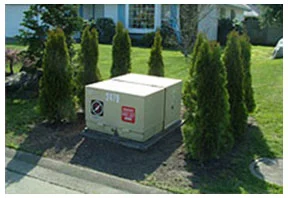Planting Trees
The best prevention for electrical tree worker accidents and service interruptions is to keep trees clear of power lines. This starts with choosing the right tree to plant in the right place. This also includes maintaining your property so that trees that voluntarily grow in the area do not reach a height that requires pruning away from power lines.
Always consider space and growth before planting trees in the yard. Trees that are too small may not provide the amount of beauty and shade you are looking for, and trees that are too large can create future problems by conflicting with your home, fences, neighbors’ yards, and yes, power lines.
Making the right decision when selecting a tree or planting site can help maintain electric reliability for you and your neighbors.

Right Tree
Choosing the right type of tree is critical to the long-term success of the tree. The type of tree planted should depend on a number of considerations, like its height and shape at maturity, or a list of its benefits and disadvantages. Tall growing trees or trees with wide canopies will require regular maintenance for utility line clearance if planted too close to power lines. These trees will be altered from their natural growth patterns, and may have stunted growth potential. Palms planted too closely to power lines will have their fronds cut, and utilities will request permission from homeowners to remove them.
Visit the University of Florida’s website for a list of recommended trees in your area or click here to view LCEC’s list of trees common to Southwest Florida.
Right Place
Trees need space to grow. It is important to study your surroundings when determining if the tree will have vertical or horizontal space to grow. Vegetation that could potentially interfere with power lines or electric facilities at mature height should be planted in a different location. Some trees may appear to be a safe distance from power lines, but can create problems during storms or high-wind events.
Tree Planting and Power Lines
Distribution
- Shrubs up to 6′ high at maturity should be planted 5′ away from the utility easement.
- Shrubs up to 10′ high should be planted 10′ from the utility easement.
- Small trees & large shrubs up to 20′ high should be planted 15′ from the utility easement.
- Medium trees up to 40′ high should be planted 30′ from the utility easement.
- Large trees over 40′ high should be planted 45′ from the utility easement.
- The distances given above are the minimum distance the plant should be placed away from the utility easement.
Transmission
For purposes of territory-wide service reliability and maximum voltage, transmission lines require greater clearances. This means tall growing trees and palms are incompatible along our transmission rights-of-way. LCEC will aggressively target large clearances and removal opportunities along these easements.
Clearances Around Underground Facilities and Poles
Customers served by underground power lines have a responsibility to keep trees, shrubs, and plants away from above ground enclosures. When landscaped plants block access to transformers and service pedestals, they interfere with LCEC’s ability to service equipment and restore power. For the larger pad-mount transformers, all vegetation must have an 8-foot space in its front and 3-feet on each side of the enclosure. Smaller pedestals should have a minimum of two feet of clearance from all vegetation. Vegetation growing around poles and in utility easements may be removed by LCEC for access, maintenance, and service restoration.

